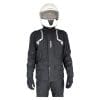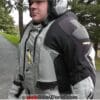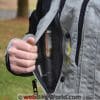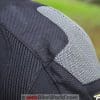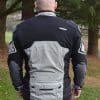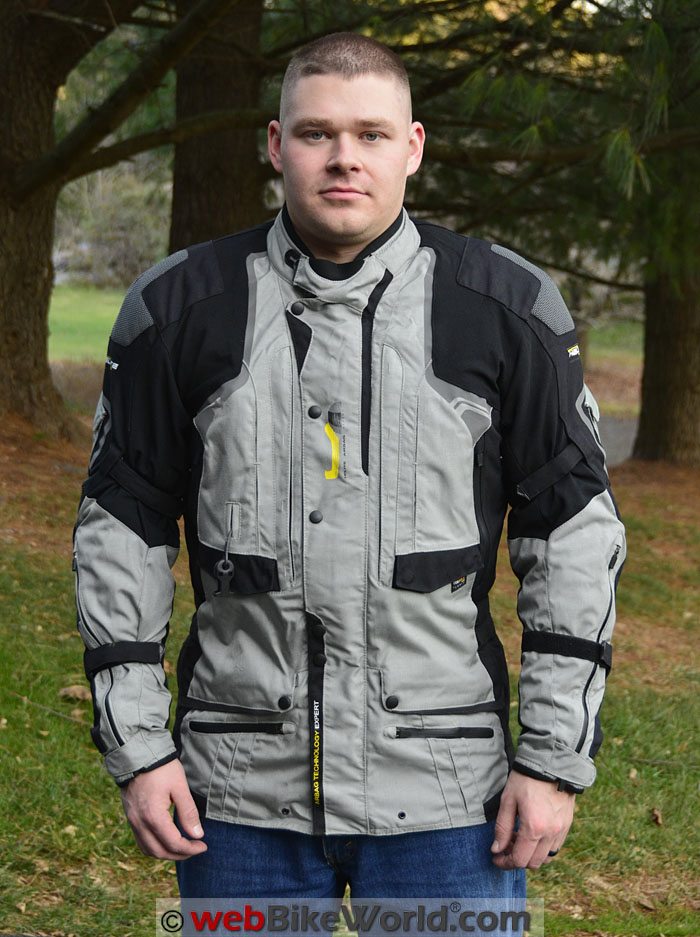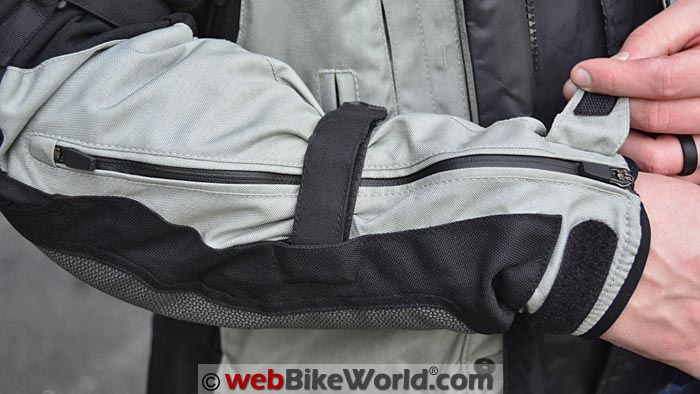The Helite Adventure jacket includes the Helite “Turtle” airbag vest, which is similar to the Helite Airnest vest we reviewed in 2012. But the Adventure jacket isn’t just about the airbag. It’s an premium jacket in its own right and it’s packed with features.
Start with a Cordura shell and a “Humax” water- and wind-proof breathable membrane liner.
Add huge swaths of Superfabric to cover the elbows, forearms and shoulders and Knox CE approved shoulder and elbow protectors. And, of course, there’s a removable thermal liner. The exterior of the jacket shell includes plenty of high-visibility reflective panels and there are plenty of pockets, including two that are waterproof.
All of this means that Helite could probably sell just the jacket without the airbag and it would be one of the most feature-rich 3/4-length jackets available. But the Turtle airbag system includes a SAS-Tec back protector.
The system uses a replaceable CO2 cartridge, said to inflate the jacket in 100 milliseconds.
Combined with the internal protectors, the airbag system with the back protector provides a remarkable amount of protection. The Helite Adventure jacket costs $170.00 more than the Helite Airnest airbag vest alone, which makes the jacket something of a bargain. Altogether, this is quite an interesting motorcycle jacket on many levels.
Introduction
Without the built-in airbag protector, we’d still be writing about the Helite Adventure jacket as a high-end 3/4-length jacket with lots of features. It looks good also, in the modern adventure-touring idiom.
Let’s cover some of the basic features first, then we’ll describe the airbag system that is incorporated into the jacket.
By the way, Helite also makes the “City” jacket, which looks very much like a non-motorcycle street jacket. It doesn’t have the Superfabric and other external styling features of the Adventure jacket but it does include the Turtle airbag system.
The City jacket could be used as a scooter/city jacket for riding to work without looking like you just came from the Dakar Rally.
The Helite Adventure Airbag Jacket
The Helite Adventure jacket is available in black and the predominantly gray shown here, with a heavyweight Cordura shell and plenty of pockets (two are waterproof).
The jacket has a breathable Texland “Humax” membrane water- and wind-proof liner (Texland is a Korean company familiar to motorcyclists as the manufacturers of Hitena, Exkin thermal liners and more).
The front, rear and sides of the jacket have sections of highly reflective fabric that really “pops” when illuminated (photo below).
The collar has an adjustable slider with a snap on a separate tab.
And the front of the jacket has a YKK main entry zipper with an overlapping wind flap on the outside that then secures with metal snaps and hook-and-loop from the left to the right side.
The overlap is quite large at about 65 mm, which is effective in blocking the wind from entering.
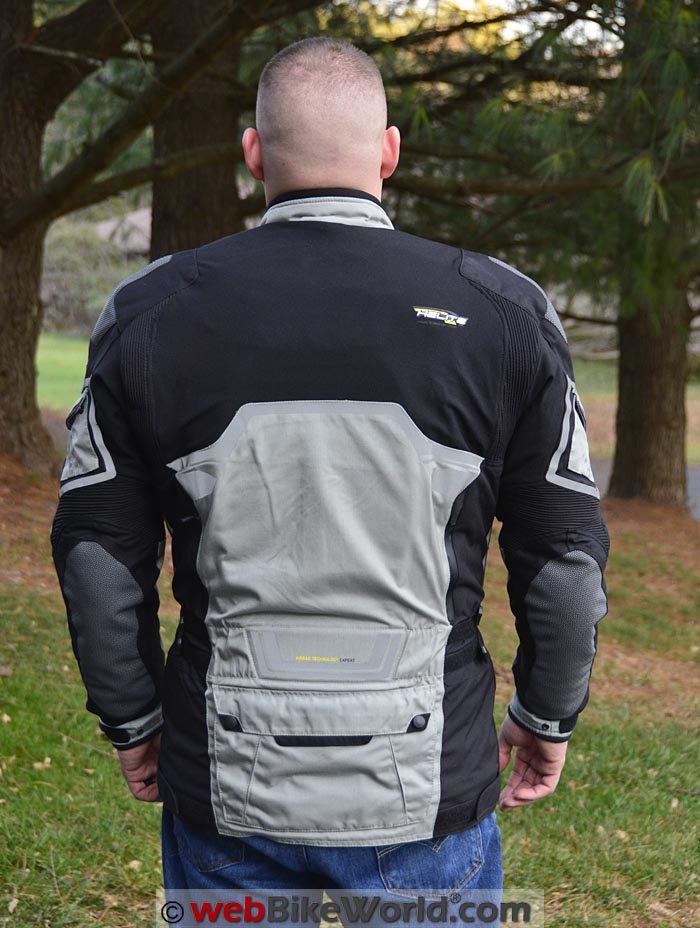
Ventilation
The Adventure jacket has four vertical vents, two in front and two in the rear and each vent has a waterproof zipper.
But one of the as-yet unsolved issues with any type of airbag vest or a jacket with an airbag is the amount of ventilation that is blocked by the impermeable airbag.
The nature of an airbag prevents air from flowing through, and thus through the jacket (in the areas where the airbag blocks the ventilation), so any vents can only provide limited air flow around the inside of the jacket shell.
Perhaps someday, this problem will be solved, maybe with something like vertical tube-shaped airbag bladders with spaces in between for air to pass through or something similar that might allow better ventilation.
On the flip side however, during colder weather (it’s currently winter), the combination of the Adventure jacket and the Humax membrane liner along with the removable thermal liner means there are no problems blocking the cold air from getting through.
The Humax liner functions nicely to reduce internal moisture buildup and there probably aren’t many jackets that are as warm and toasty for winter riding.
Wide Range of Adjustment
The arms of the jacket have two hook-and-loop strap adjusters to keep the protectors in place, so no problem there.
The adjusters are hook-and-loop types, one on the upper arm and one below the elbow protector around the forearm.
The nylon “D” ring that the adjuster strap loops around is cleverly hidden under part of the black fabric on the seam of the upper and lower arms, which hides a portion of the adjuster strap and gives it an “endless” appearance.
This is one of the subtle touches that mark the Adventure jacket as more than your average generic 3/4-length jacket with an airbag stuck on for good measure.
Touches like this and the Superfabric are among the reasons we think the jacket could actually stand on its own, even without the airbag.
The Adventure jacket has a very wide range of adjustment (and corresponding sizing range) to account for the airbag when and if it inflates. As an example, there are snap adjusters under each arm to tighten the fit at the underside of the shoulder if desired.
Dual hook-and-loop straps also on each side at the waist give the Adventure jacket a wide range of width adjustment.
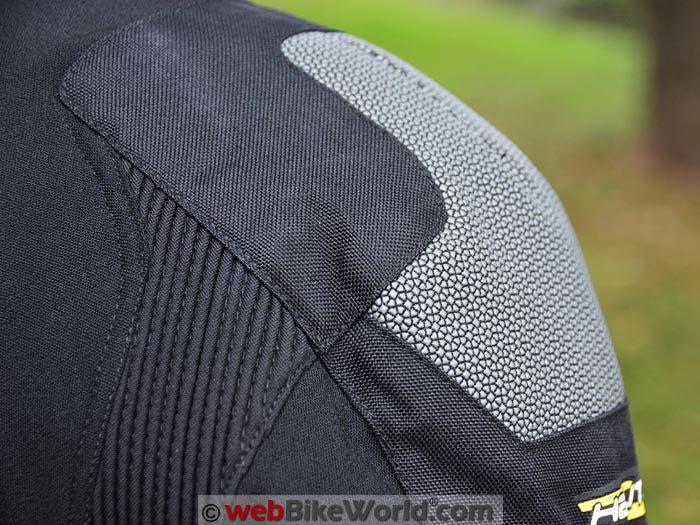
Superfabric
One of the most noticeable features is the large sections of Superfabric covering the outside of the elbows and forearms and the shoulders.
This is the latest version of Superfabric, which consists of tiny armor “plates” in all sorts of shapes and sizes.
The Superfabric on the Adventure jacket is made from thousands of tiny polygon shaped Superfabric ceramic pieces.
The pattern is 8 trapezoidal-shaped pieces surrounding a central square forming an octagon, where the trapezoids from one octagon are also part of the surrounding octagons circling their squares, on to infinity.
It’s quite something to view and has a sort of mesmerizing effect if you stare at it too long!
This is completely different from the Superfabric of several years ago, which felt stiff and was difficult for the manufacturer to incorporate.
The Superfabric of today is very flexible; in fact, it feels very similar to the surrounding Cordura in terms of both feel and flexibility.
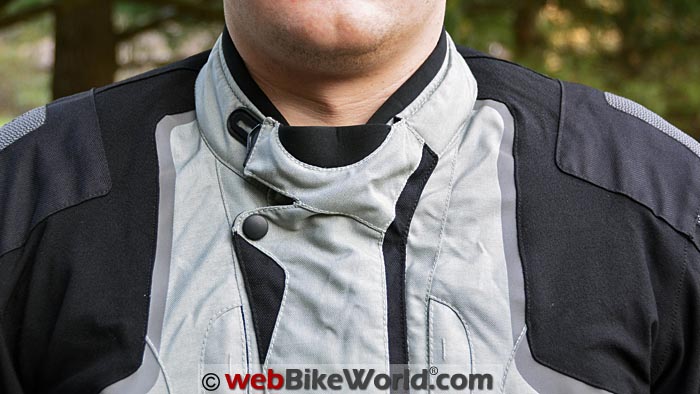
Pockets
The Adventure jacket has an excellent selection of pockets. The two lower pockets on the outside of the jacket deserve special mention. They are covered with a flap and dual metal snaps underneath the outside corners.
The snap towards the inside is visible and has a rubberized cover; the outside snap is hidden underneath the flap.
In addition to the snaps, the flap has a 75 mm long section of hook-and-loop underneath, so these flaps are definitely going to remain in place.
The flap also has a section of rubberized vinyl along the lower edge to provide grip. Lift the flap and underneath is a waterproof zipper to enter the pocket. So each of the lower pockets is waterproof and quite secure.
Above those two waterproof pockets and forming the flap are two more pockets.
These are marked as non-waterproof but they’re huge, about 200 mm deep and 150 mm wide. They secure with a black flap with two hidden snaps underneath.
Below the main pockets are secondary smaller pockets, covered with a waterproof zipper. These are easier to access, especially when riding, as these pockets are located more or less like a thigh pocket on a pair of pants.
Both arms have a small 100 mm by 100 mm expanding pocket on the upper arm, sewn at an angle towards the rider.
These also are covered with a flap with the rubberized grip and also with two small snaps hidden underneath. Also, both pockets are lined with vinyl.
Inside the left placket is a 175 mm long YKK vertical zipper that reveals another deep waterproof pocket; it measures about 175 mm on the angle.
Finally, in the rear of the jacket there’s a full-width storage pocket with a wide flap cover that has two snaps (rubberized on the outside) and a vinyl lining.
But wait — there are two more pockets inside the thermal zip-out liner.
The pocket on the left holds a phone while the pocket on the right has a horizontal zipper on top and can be used for more storage.
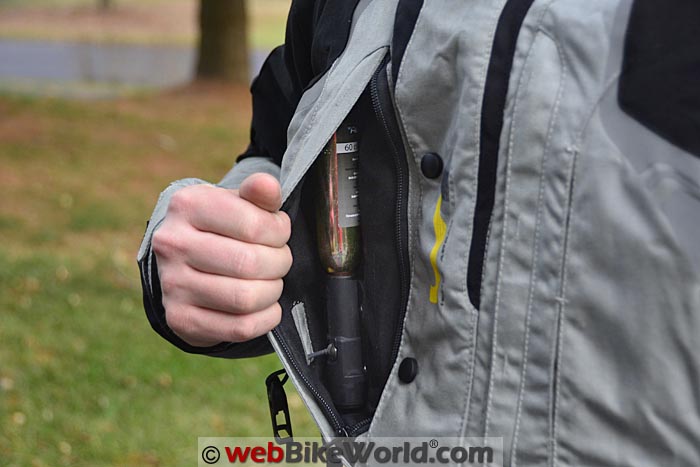
Helite “Airnest” vs. “Turtle” Airbag System
OK, let’s get to the main point of interest with the Adventure jacket — the included airbag protection system.
The airbag used in the Adventure jacket is the Helite “Turtle” airbag vest, which is new addition to the Helite product line. The Airnest vest that we reviewed in 2012 remains in production also.
We described the Helite Airnest Vest in our review back in 2012, which also includes a video showing the inflation of the airbag. The Airnest vest can be worn under or over a motorcycle jacket.
The difference between the two is that the Airnest vest has a removable SAS-Tec back protector on the inside of the airbag, to account for racing leathers with an external “hump” or back protector.
The Turtle airbag vest has the SAS-Tec back protector on the outside of the airbag, to account for most motorcycle street jackets that don’t include a protector.
It is possible — but difficult — to remove the Turtle airbag vest from the Adventure jacket; there’s a full-length zipper at the bottom of the hem on the inside of the jacket.
But I looked around inside and can’t quite figure out how to remove it, so I’ll leave that one unanswered.
How It Works
The Helite airbag system inflates via a large CO2 cartridge that measures about 35 mm in diameter by 135 mm long. The CO2 cartridges are sized by the weight of the rider:
- Airnest and Turtle Vest: 50 cc canister for children; 60 cc canister for small adult; 100 cc canister for adult size L and XL.
- Adventure and City Jackets: Both jackets use the 60 cc canister for all jacket sizes.
The airbag is designed to protect the back of the head, the neck, chest, ribs, collarbone, lungs, abdomen, pancreas, pelvis, and vertebrae.
Helite said that “approximately 40% of fatalities from motorcycle accidents in France in 2011 were due to a chest injury, so protecting the front parts of your body is as important as protecting your back.”
As with the Airnest vest that we reviewed, the airbag vest basically forms two large loops around the front and rear of the body.
The upper rear portion of the airbag then forms a “hump” that helps prevent the helmet from moving too far backwards. This helps to delay a helmet impact and provides support around the bottom of the helmet, similar to a Leatt neck brace (review).
I borrowed a couple of graphics from the Helite Moto website to illustrate the system:
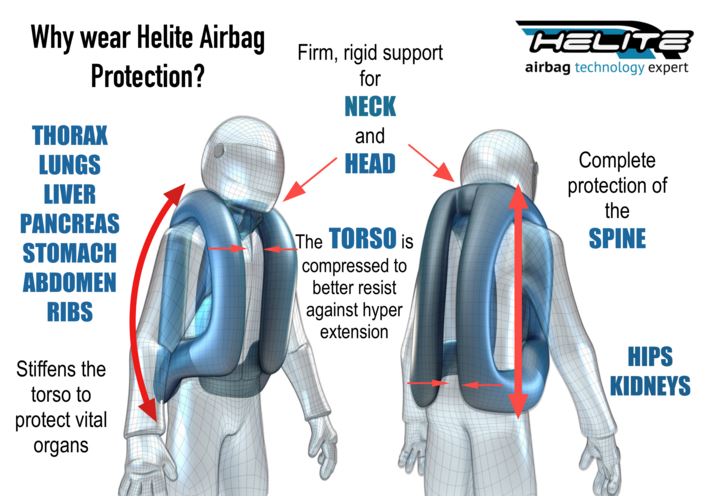
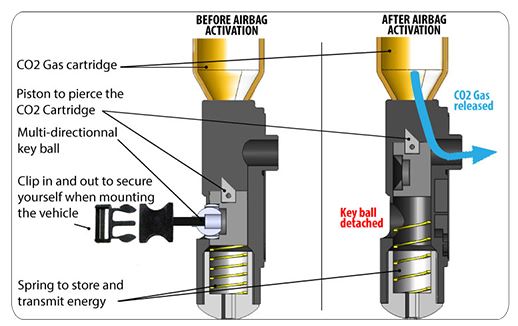
The Airbag Inflation System
The CO2 cartridge is well-hidden behind a large vertical zipper on the left side of the jacket in front. In fact, we had to search around for a while to find the cartridge, it’s that well hidden.
Probably if no one told you this jacket had an airbag, you’d never know it. Or at the very least, it would take a while to realize it.
The CO2 cartridge screws into the top of the inflation system.
It’s actually a fairly simple system, with a heavy spring at one end and a ball between the spring and the sharp wedge that pierces the CO2 canister to inflate the vest.
The ball is on a metal cable that leads outside the jacket through a small opening on the left chest side of the jacket. That attaches to a cord that you fix to the bike.
If the airbag deploys, simply screw in another CO2 canister (best to buy them directly from Helite) and you’re ready to go again, as long as the jacket or the airbag hasn’t been damaged.
Inflator Cable Attachment
The inflator cable and the cord are attached with a plastic spring clip, so you can leave the cord attached to the bike and then attach or detach it with the clip when you get on and off.
For the Adventure jacket, the cord needs somewhere between 45 and 60 pounds of force to activate the airbag inflation system.
Since the Helite airbag uses a mechanical actuation system and not an electronic system, there are some variances to consider.
These include the amount of force required to deploy the airbag vs. the rider’s weight; how much length you should leave for the cord on the bike and what happens if the accident involves a slow get-off, like in a lowside.
We don’t know all of the answers and hope that some Helite airbag vest or Adventure jacket owners who have experienced an activation will write to let us know the details.
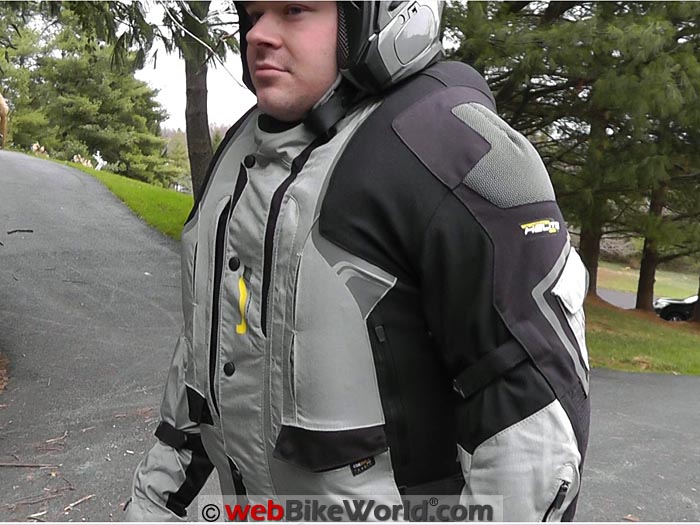
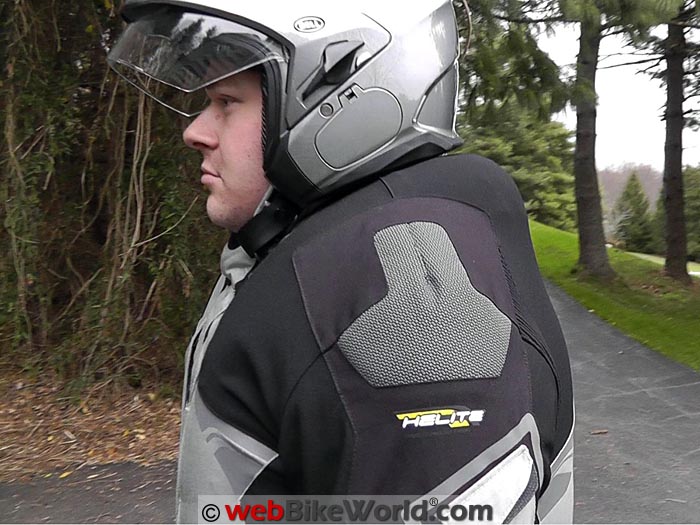
Fit and Sizing
The Adventure jacket is available in an expanded (pun?) size range: S, M, L, then L+, XL and XL+.
This jacket is a size XL and it fits about like a slightly roomy size large. We probably could have worn an L+ instead.
The model shown here has a 44″ chest and the Adventure jacket in size XL is listed as fitting a 43″ to 49″ chest, which is a very wide range. Helite said to contact them if you have a question on fit.
One factor to note is that this Adventure jacket in size XL weighs just shy of 4.5 kg (10 lbs.).
That’s pretty hefty for a 3/4-length jacket, although it’s not really noticeable when riding and the array of adjustment straps on the jacket help to keep it snug.
We estimate that the airbag system and the back protector probably add about 1.5 kg to the overall weight of the jacket.
wBW Video: Helite Adventure Jacket Airbag Deployment
On the Road With the Adventure Jacket
To be perfectly honest, in terms of overall feel, there’s no difference wearing the Adventure jacket than any other high-end 3/4-length jacket.
The weight is there but when you’re sitting on the bike, it’s not very noticeable.
Once you find a suitable location to secure the airbag deployment strap on the bike, it’s then a matter of remembering to “buckle up”.
You do this by attaching the deployment strap attached to the bike to the cable deployment strap that sticks out of the jacket mid-chest on the right side.
This becomes a habit just like buckling the seatbelt in a car.
When you get off the bike, unfasten the snap connector and you’re ready to go. If you don’t, you’ll feel a light tug as you get off the bike or start to move away and this certainly isn’t enough to deploy the airbag.
In fact, most owners will probably never deploy the airbag, or at least let’s hope so.
It’s very much like a seatbelt and/or airbag system on your car; it’s there, always ready to deploy but hopefully you will drive hundreds of thousands of kilometers or miles and never have to use it.
Helite said there are something like over 40,000 Helite airbags in the form of the Airnest and Turtle vests and the Adventure jacket in use all around the world.
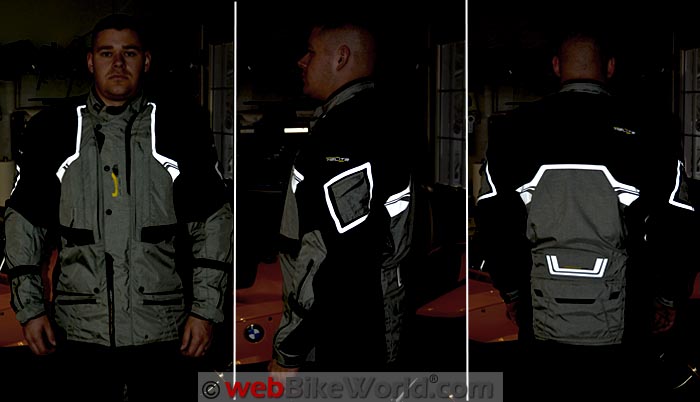
Conclusion
Two things strike us as immediately apparent with the Helite Adventure jacket. First, the jacket is loaded with all of the high-end features one might expect from REV’IT!, Dainese, Klim, Rukka, Alpinestars, etc. And second, the top-of-the-line jackets from those companies will cost about the same (or more) as the Helite Adventure jacket but you wouldn’t get the airbag system and perhaps not even the back protector.
So in comparison, the Helite Adventure jacket is a relative bargain. Of course, there’s no guarantee that the airbag will provide 100% protection in a crash, and since this technology is so new for motorcycling, it may be some time before we have actual data to support the contention.
And there’s still a lot of evolution to be had in the science and technology of airbag protection for motorcycling. But in the meantime, common sense indicates that the deployment of an airbag system should be an additional level of protection to be considered for many motorcycle owners.
The Helite Adventure jacket brings airbag technology into the mainstream and maybe the best part about it is that the jacket is designed in such a way that there’s very little noticeable difference between this and a “normal” 3/4-length jacket.
More webBikeWorld:
| wBW Review: Helite Adventure Jacket | |
|---|---|
| Manufacturer: Helite Moto | List Price (2016): $799.00 |
| Colors: Black or gray/black | Made In: Pakistan |
| Sizes: S-XL | Review Date: January 2016 |
Owner Comments and Feedback
See details on submitting comments.
From “B.D.” (August 2016): “I’ve been using this jacket of about 7 months now (since November 2015) and until very recently have been very happy with it.
It’s a high spec and very comfortable (if a little on the heavy side) jacket that provides excellent water resistance and heat retention on a rainy UK winter day.
It’s also pretty good during the more temperate time of year.
That said, here’s the down side: since the weather warmed up the ventilation has proved to be a significant problem.
I literally ‘cook’ in this jacket, even in the relatively mild UK summer heat, and removing the thermal line hasn’t helped at all — in fact it’s probably best left in!!
I wouldn’t even try this jacket in southern Europe which makes it a bit of a problem for summer touring.
The jacket would be immeasurably better if it had a Gore-Tex Pro-Shell construction and could breath a bit, especially in hot weather.
On the whole this jacket is definitely an 8/10 but could go head to head with RUKKA or KLIM if it had a higher spec fabric construction, i.e. Gore-Tex Pro.”
From “G.J.” (January 2016): “Hi, I thought I’d get in touch re your review as I’ve been using one of these jackets for a couple of months now on Bloodbike duty in the UK – not a comprehensive test but if you like a decent working assessment of the product.
And to be honest you’ve nailed it. It’s an excellent quality jacket (better than my Hein Gericke, and that’s a real compliment) and while pockets are slightly unusual compared with a normal jacket, you very soon appreciate them.
It’s very comfortable and warm in British winter conditions, and as you say the use of the tether soon becomes second nature.
We’ve had some torrential rain here and the jacket has been totally waterproof. My only reservation is what it will be like in summer, although the opening the body vents does make a noticeable difference, as does opening the cuff vents. And of course the liner zips out.
All in all, an impressive product and I’m pleased that I swapped over from the Airnest.”
From “C.H.” (January 2016): “This is the best motorcycle airbag set up I have seen yet. I’m interested to see how it works out for you guys over the course of the testing period. I also love the look on the face of your crash test dummy right before you detonated the inflator!”
From “S.S.” (January 2016): “That is an interesting review, and the included video is especially helpful to gain a sense of just how quickly deployment occurs.
Is the design like an airbag in a car, which is packed a certain way and has to be replaced by a dealer, or does the owner simply replace the CO2 cartridge and tuck things back into place?”
Rick’s Reply: There’s no re-packing, just screw in a new CO2 cartridge and you’re ready to go, as long as the jacket hasn’t been damaged.
From “P.L.” (January 2016): “I happen to have attended a demonstration of the Helite safety vest today, so seeing the jacket review on webBikeWorld really raised my attention.
Next year I think about replacing my current jacket with a jacket with integrated waterproof/breathing liner, type Gore-Tex. Because my current vest soaks up too much water. And I do not always carry additional rain gear (which doesn’t breathe, either).
But having a jacket with airbag also has advantages. Especially as the jacket does not have carry large price premium over the basic safety vest.
Could you tell me more about how the jacket holds up in wet conditions?”
Rick’s Reply: It’s difficult to say, as it’s winter here, we had a little snow in the hills the other day but no rain in quite some time. The jacket is supposed to be waterproof and it has the Humax membrane lining.
Unfortunately I have to return the jacket so we’ll probably never know for sure but I feel pretty confident that it is waterproof, although as mentioned in the review, with the airbag inside, it can get pretty warm in warm weather.



